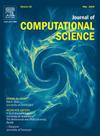Bayesian approaches for revealing complex neural network dynamics in Parkinson’s disease
IF 3.7
3区 计算机科学
Q2 COMPUTER SCIENCE, INTERDISCIPLINARY APPLICATIONS
引用次数: 0
Abstract
Parkinson’s disease (PD) belongs to the class of neurodegenerative disorders that affect the central nervous system. It is usually defined as the gradual loss of dopaminergic neurons in the substantia nigra pars compacta, which causes both motor and non-motor symptoms. Understanding the neuronal processes that underlie PD is critical for creating successful therapies. This study combines machine learning (ML), stochastic modelling, and Bayesian inference with connectomic data to analyse the brain networks involved in PD. We use modern computational methods to study large-scale neural networks to identify neuronal activity patterns related to PD development. We aim to define the subtle structural and functional connection changes in PD brains by combining connectomic with stochastic noises. Stochastic modelling approaches reflect brain dynamics’ intrinsic variability and unpredictability, shedding light on the origin and spread of pathogenic events in PD. We employ a novel hybrid model to assess how stochastic noise impacts the cortex-basal ganglia-thalamus (CBGTH) network, using data from the Human Connectome Project (HCP). Bayesian inference allows us to quantify uncertainty in model parameters, improving the accuracy of our predictions. Our findings reveal that stochastic disturbances increase thalamus activity, even under deep brain stimulation (DBS). Bayesian analysis suggests that reducing these disturbances could enhance healthy brain states, providing insights for potential therapeutic interventions. This approach offers a deeper understanding of PD dynamics and paves the way for personalized treatment strategies. This is an extended version of our work presented at the ICCS-2024 conference (Shaheen and Melnik, 2024)[1].
揭示帕金森病复杂神经网络动力学的贝叶斯方法
帕金森病(PD)属于影响中枢神经系统的神经退行性疾病。它通常被定义为黑质致密部多巴胺能神经元的逐渐丧失,引起运动和非运动症状。了解PD背后的神经元过程对于创造成功的治疗方法至关重要。本研究结合机器学习(ML)、随机建模和贝叶斯推理与连接组数据来分析PD中涉及的大脑网络。我们使用现代计算方法来研究大规模神经网络,以识别与PD发展相关的神经元活动模式。我们将连接组学与随机噪声相结合,研究PD脑内细微的结构和功能连接变化。随机建模方法反映了脑动力学的内在变异性和不可预测性,揭示了PD发病事件的起源和传播。我们采用一种新的混合模型来评估随机噪声如何影响皮质-基底神经节-丘脑(CBGTH)网络,使用来自人类连接组项目(HCP)的数据。贝叶斯推理允许我们量化模型参数的不确定性,提高我们预测的准确性。我们的研究结果表明,即使在深部脑刺激(DBS)下,随机干扰也会增加丘脑活动。贝叶斯分析表明,减少这些干扰可以增强健康的大脑状态,为潜在的治疗干预提供见解。这种方法提供了对PD动力学更深入的理解,并为个性化治疗策略铺平了道路。这是我们在ICCS-2024会议上提出的工作的扩展版本(Shaheen和Melnik, 2024)。
本文章由计算机程序翻译,如有差异,请以英文原文为准。
求助全文
约1分钟内获得全文
求助全文
来源期刊

Journal of Computational Science
COMPUTER SCIENCE, INTERDISCIPLINARY APPLICATIONS-COMPUTER SCIENCE, THEORY & METHODS
CiteScore
5.50
自引率
3.00%
发文量
227
审稿时长
41 days
期刊介绍:
Computational Science is a rapidly growing multi- and interdisciplinary field that uses advanced computing and data analysis to understand and solve complex problems. It has reached a level of predictive capability that now firmly complements the traditional pillars of experimentation and theory.
The recent advances in experimental techniques such as detectors, on-line sensor networks and high-resolution imaging techniques, have opened up new windows into physical and biological processes at many levels of detail. The resulting data explosion allows for detailed data driven modeling and simulation.
This new discipline in science combines computational thinking, modern computational methods, devices and collateral technologies to address problems far beyond the scope of traditional numerical methods.
Computational science typically unifies three distinct elements:
• Modeling, Algorithms and Simulations (e.g. numerical and non-numerical, discrete and continuous);
• Software developed to solve science (e.g., biological, physical, and social), engineering, medicine, and humanities problems;
• Computer and information science that develops and optimizes the advanced system hardware, software, networking, and data management components (e.g. problem solving environments).
 求助内容:
求助内容: 应助结果提醒方式:
应助结果提醒方式:


